Analysis of Knowledge Management System at Bouygues Telecom
VerifiedAdded on 2022/10/18
|10
|2198
|19
Report
AI Summary
This report provides an in-depth analysis of knowledge management principles and their application within Bouygues Telecom. It begins with an introduction to knowledge management, its importance, and a brief overview of the case study. The report then delves into the challenges faced by Bouygues Telecom in managing information flow and fostering collaboration. It explores the strategies adopted by the company, including the implementation of IT tools like Microsoft SharePoint Portal and SAP, to enhance knowledge management. The report further examines the company's approach to sharing tacit knowledge and converting it into explicit knowledge, highlighting the role of online libraries and digital transformation. The conclusion summarizes the key findings and emphasizes the link between IT and effective knowledge management practices, offering valuable insights into the practical application of these concepts within a large telecommunications company.
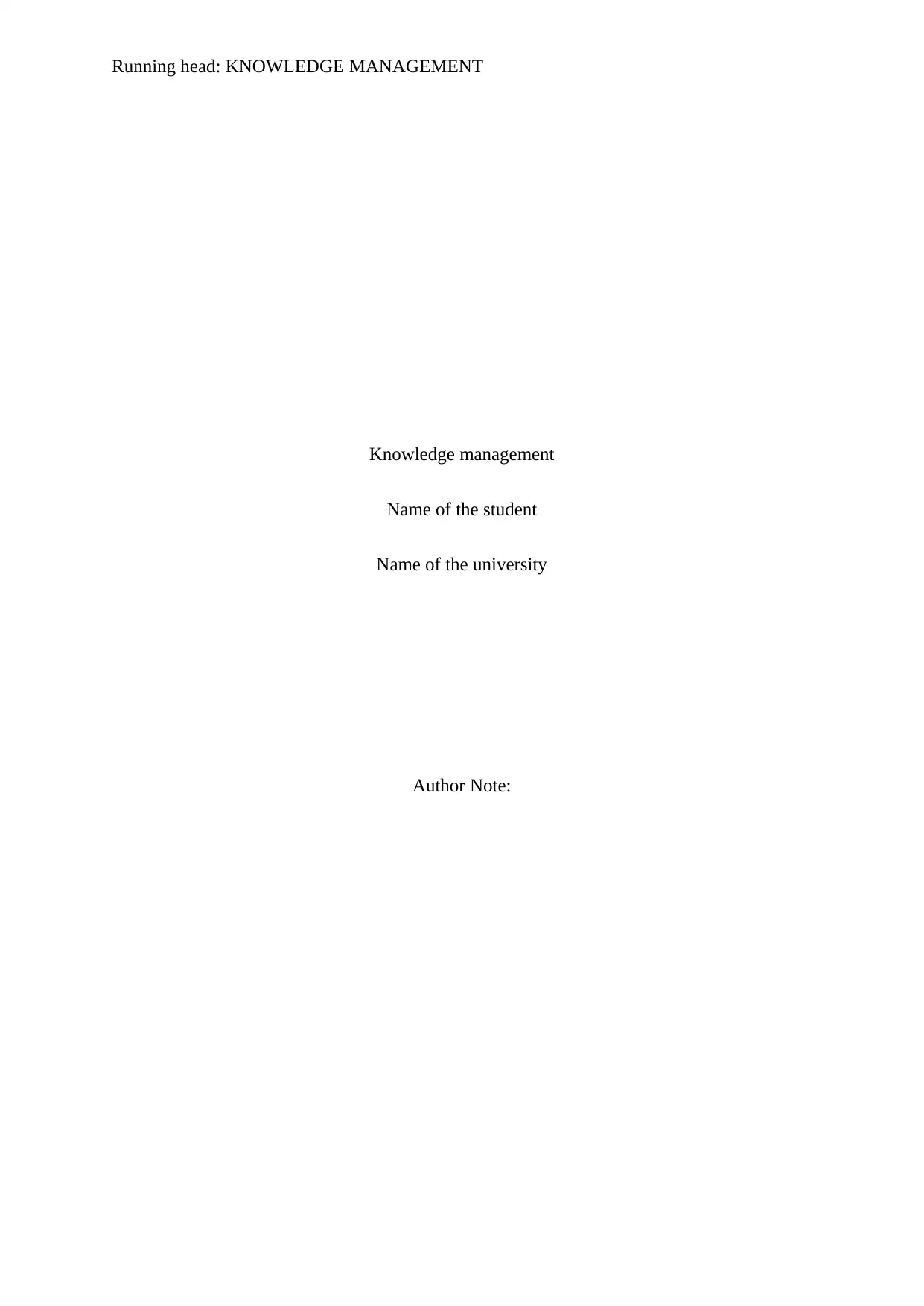
Running head: KNOWLEDGE MANAGEMENT
Knowledge management
Name of the student
Name of the university
Author Note:
Knowledge management
Name of the student
Name of the university
Author Note:
Paraphrase This Document
Need a fresh take? Get an instant paraphrase of this document with our AI Paraphraser
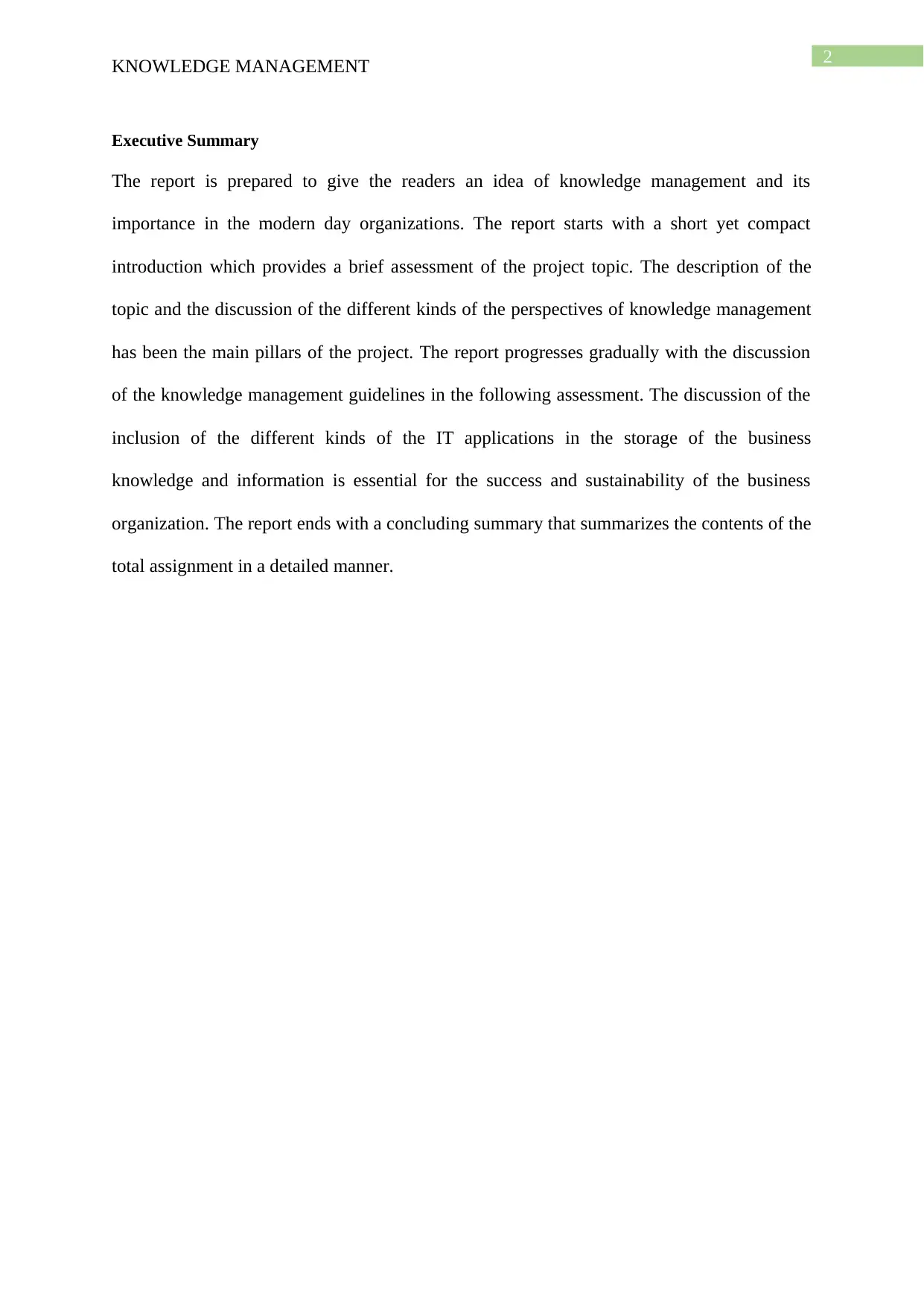
2
KNOWLEDGE MANAGEMENT
Executive Summary
The report is prepared to give the readers an idea of knowledge management and its
importance in the modern day organizations. The report starts with a short yet compact
introduction which provides a brief assessment of the project topic. The description of the
topic and the discussion of the different kinds of the perspectives of knowledge management
has been the main pillars of the project. The report progresses gradually with the discussion
of the knowledge management guidelines in the following assessment. The discussion of the
inclusion of the different kinds of the IT applications in the storage of the business
knowledge and information is essential for the success and sustainability of the business
organization. The report ends with a concluding summary that summarizes the contents of the
total assignment in a detailed manner.
KNOWLEDGE MANAGEMENT
Executive Summary
The report is prepared to give the readers an idea of knowledge management and its
importance in the modern day organizations. The report starts with a short yet compact
introduction which provides a brief assessment of the project topic. The description of the
topic and the discussion of the different kinds of the perspectives of knowledge management
has been the main pillars of the project. The report progresses gradually with the discussion
of the knowledge management guidelines in the following assessment. The discussion of the
inclusion of the different kinds of the IT applications in the storage of the business
knowledge and information is essential for the success and sustainability of the business
organization. The report ends with a concluding summary that summarizes the contents of the
total assignment in a detailed manner.
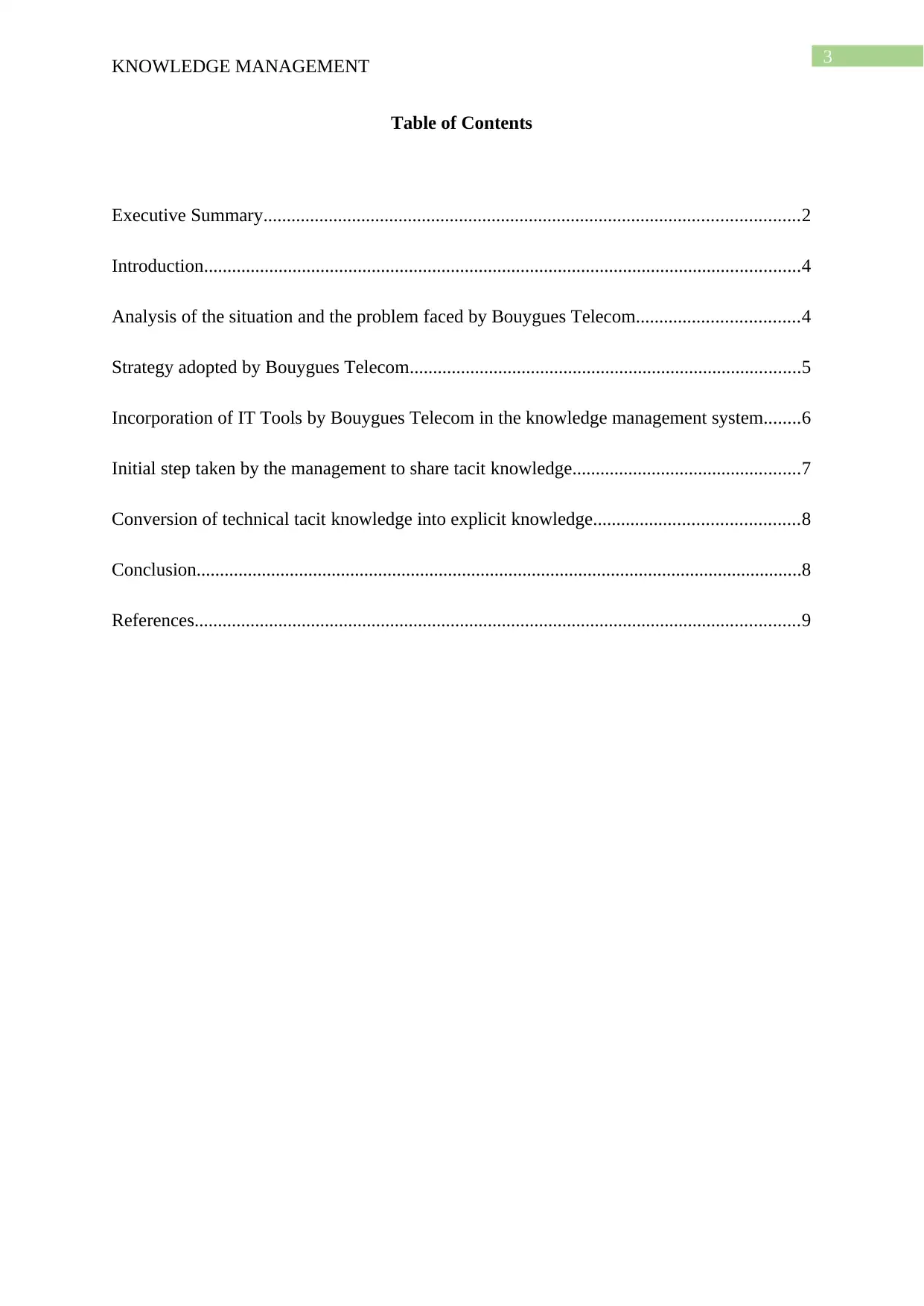
3
KNOWLEDGE MANAGEMENT
Table of Contents
Executive Summary...................................................................................................................2
Introduction................................................................................................................................4
Analysis of the situation and the problem faced by Bouygues Telecom...................................4
Strategy adopted by Bouygues Telecom....................................................................................5
Incorporation of IT Tools by Bouygues Telecom in the knowledge management system........6
Initial step taken by the management to share tacit knowledge.................................................7
Conversion of technical tacit knowledge into explicit knowledge............................................8
Conclusion..................................................................................................................................8
References..................................................................................................................................9
KNOWLEDGE MANAGEMENT
Table of Contents
Executive Summary...................................................................................................................2
Introduction................................................................................................................................4
Analysis of the situation and the problem faced by Bouygues Telecom...................................4
Strategy adopted by Bouygues Telecom....................................................................................5
Incorporation of IT Tools by Bouygues Telecom in the knowledge management system........6
Initial step taken by the management to share tacit knowledge.................................................7
Conversion of technical tacit knowledge into explicit knowledge............................................8
Conclusion..................................................................................................................................8
References..................................................................................................................................9
⊘ This is a preview!⊘
Do you want full access?
Subscribe today to unlock all pages.

Trusted by 1+ million students worldwide
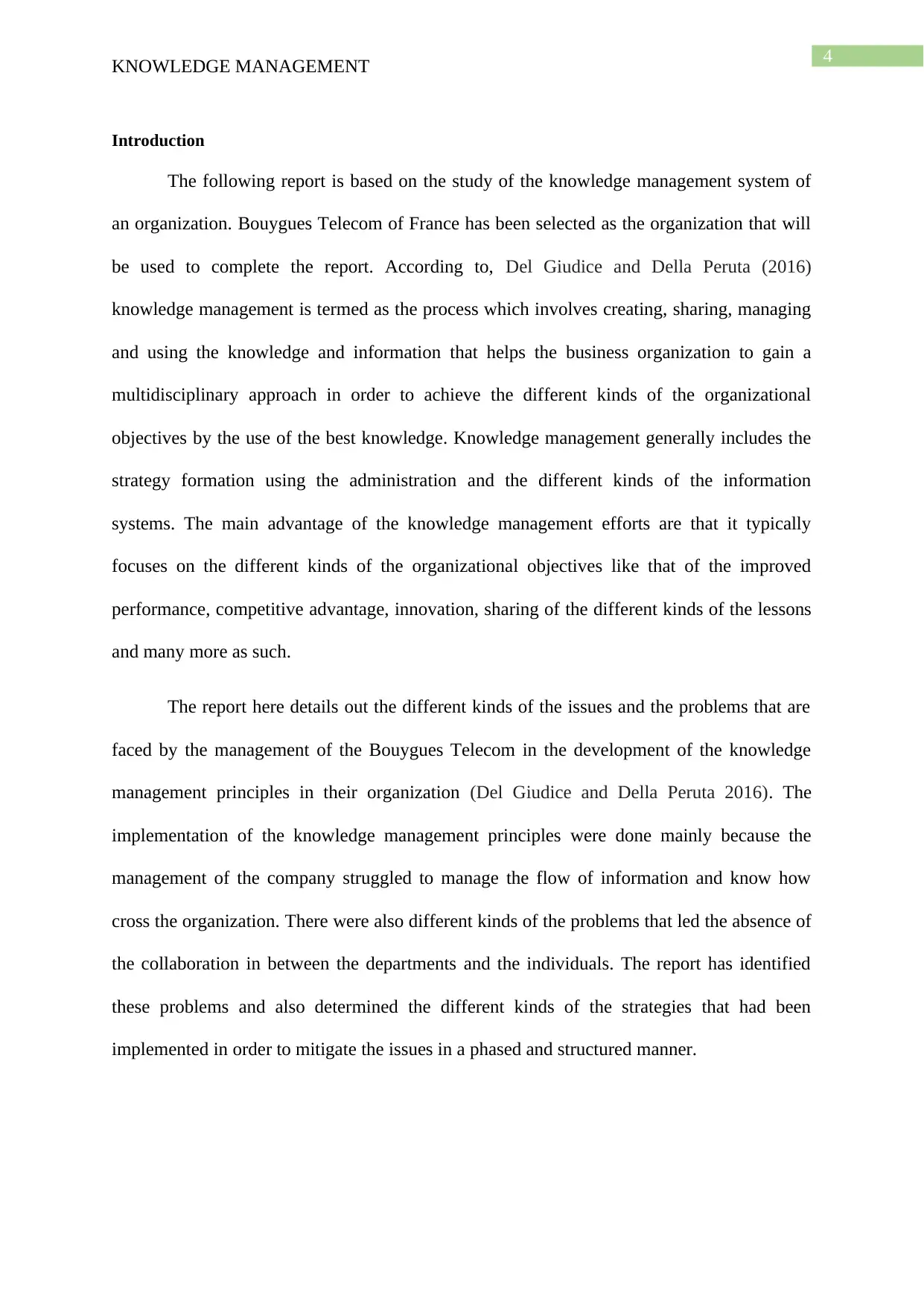
4
KNOWLEDGE MANAGEMENT
Introduction
The following report is based on the study of the knowledge management system of
an organization. Bouygues Telecom of France has been selected as the organization that will
be used to complete the report. According to, Del Giudice and Della Peruta (2016)
knowledge management is termed as the process which involves creating, sharing, managing
and using the knowledge and information that helps the business organization to gain a
multidisciplinary approach in order to achieve the different kinds of the organizational
objectives by the use of the best knowledge. Knowledge management generally includes the
strategy formation using the administration and the different kinds of the information
systems. The main advantage of the knowledge management efforts are that it typically
focuses on the different kinds of the organizational objectives like that of the improved
performance, competitive advantage, innovation, sharing of the different kinds of the lessons
and many more as such.
The report here details out the different kinds of the issues and the problems that are
faced by the management of the Bouygues Telecom in the development of the knowledge
management principles in their organization (Del Giudice and Della Peruta 2016). The
implementation of the knowledge management principles were done mainly because the
management of the company struggled to manage the flow of information and know how
cross the organization. There were also different kinds of the problems that led the absence of
the collaboration in between the departments and the individuals. The report has identified
these problems and also determined the different kinds of the strategies that had been
implemented in order to mitigate the issues in a phased and structured manner.
KNOWLEDGE MANAGEMENT
Introduction
The following report is based on the study of the knowledge management system of
an organization. Bouygues Telecom of France has been selected as the organization that will
be used to complete the report. According to, Del Giudice and Della Peruta (2016)
knowledge management is termed as the process which involves creating, sharing, managing
and using the knowledge and information that helps the business organization to gain a
multidisciplinary approach in order to achieve the different kinds of the organizational
objectives by the use of the best knowledge. Knowledge management generally includes the
strategy formation using the administration and the different kinds of the information
systems. The main advantage of the knowledge management efforts are that it typically
focuses on the different kinds of the organizational objectives like that of the improved
performance, competitive advantage, innovation, sharing of the different kinds of the lessons
and many more as such.
The report here details out the different kinds of the issues and the problems that are
faced by the management of the Bouygues Telecom in the development of the knowledge
management principles in their organization (Del Giudice and Della Peruta 2016). The
implementation of the knowledge management principles were done mainly because the
management of the company struggled to manage the flow of information and know how
cross the organization. There were also different kinds of the problems that led the absence of
the collaboration in between the departments and the individuals. The report has identified
these problems and also determined the different kinds of the strategies that had been
implemented in order to mitigate the issues in a phased and structured manner.
Paraphrase This Document
Need a fresh take? Get an instant paraphrase of this document with our AI Paraphraser
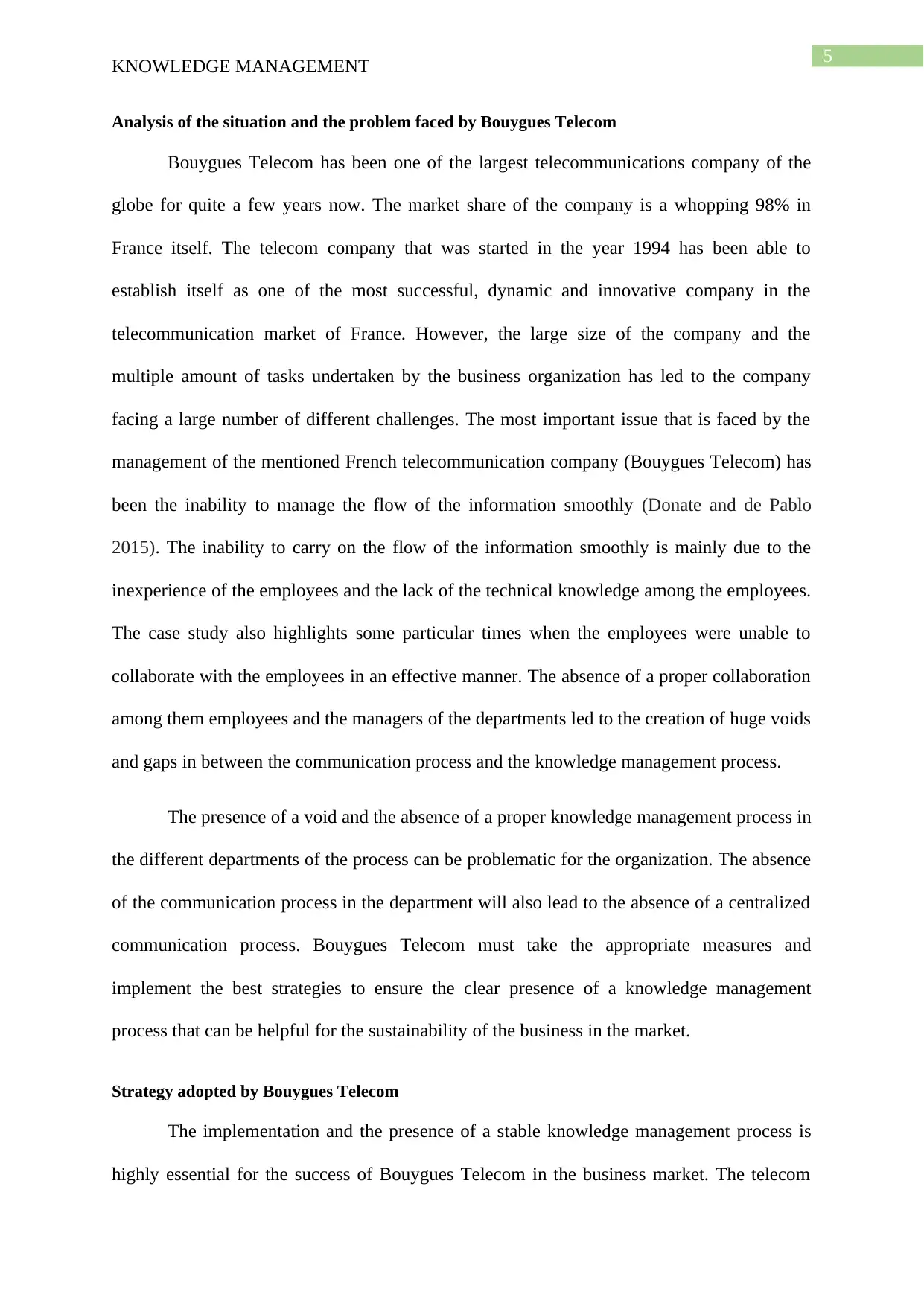
5
KNOWLEDGE MANAGEMENT
Analysis of the situation and the problem faced by Bouygues Telecom
Bouygues Telecom has been one of the largest telecommunications company of the
globe for quite a few years now. The market share of the company is a whopping 98% in
France itself. The telecom company that was started in the year 1994 has been able to
establish itself as one of the most successful, dynamic and innovative company in the
telecommunication market of France. However, the large size of the company and the
multiple amount of tasks undertaken by the business organization has led to the company
facing a large number of different challenges. The most important issue that is faced by the
management of the mentioned French telecommunication company (Bouygues Telecom) has
been the inability to manage the flow of the information smoothly (Donate and de Pablo
2015). The inability to carry on the flow of the information smoothly is mainly due to the
inexperience of the employees and the lack of the technical knowledge among the employees.
The case study also highlights some particular times when the employees were unable to
collaborate with the employees in an effective manner. The absence of a proper collaboration
among them employees and the managers of the departments led to the creation of huge voids
and gaps in between the communication process and the knowledge management process.
The presence of a void and the absence of a proper knowledge management process in
the different departments of the process can be problematic for the organization. The absence
of the communication process in the department will also lead to the absence of a centralized
communication process. Bouygues Telecom must take the appropriate measures and
implement the best strategies to ensure the clear presence of a knowledge management
process that can be helpful for the sustainability of the business in the market.
Strategy adopted by Bouygues Telecom
The implementation and the presence of a stable knowledge management process is
highly essential for the success of Bouygues Telecom in the business market. The telecom
KNOWLEDGE MANAGEMENT
Analysis of the situation and the problem faced by Bouygues Telecom
Bouygues Telecom has been one of the largest telecommunications company of the
globe for quite a few years now. The market share of the company is a whopping 98% in
France itself. The telecom company that was started in the year 1994 has been able to
establish itself as one of the most successful, dynamic and innovative company in the
telecommunication market of France. However, the large size of the company and the
multiple amount of tasks undertaken by the business organization has led to the company
facing a large number of different challenges. The most important issue that is faced by the
management of the mentioned French telecommunication company (Bouygues Telecom) has
been the inability to manage the flow of the information smoothly (Donate and de Pablo
2015). The inability to carry on the flow of the information smoothly is mainly due to the
inexperience of the employees and the lack of the technical knowledge among the employees.
The case study also highlights some particular times when the employees were unable to
collaborate with the employees in an effective manner. The absence of a proper collaboration
among them employees and the managers of the departments led to the creation of huge voids
and gaps in between the communication process and the knowledge management process.
The presence of a void and the absence of a proper knowledge management process in
the different departments of the process can be problematic for the organization. The absence
of the communication process in the department will also lead to the absence of a centralized
communication process. Bouygues Telecom must take the appropriate measures and
implement the best strategies to ensure the clear presence of a knowledge management
process that can be helpful for the sustainability of the business in the market.
Strategy adopted by Bouygues Telecom
The implementation and the presence of a stable knowledge management process is
highly essential for the success of Bouygues Telecom in the business market. The telecom
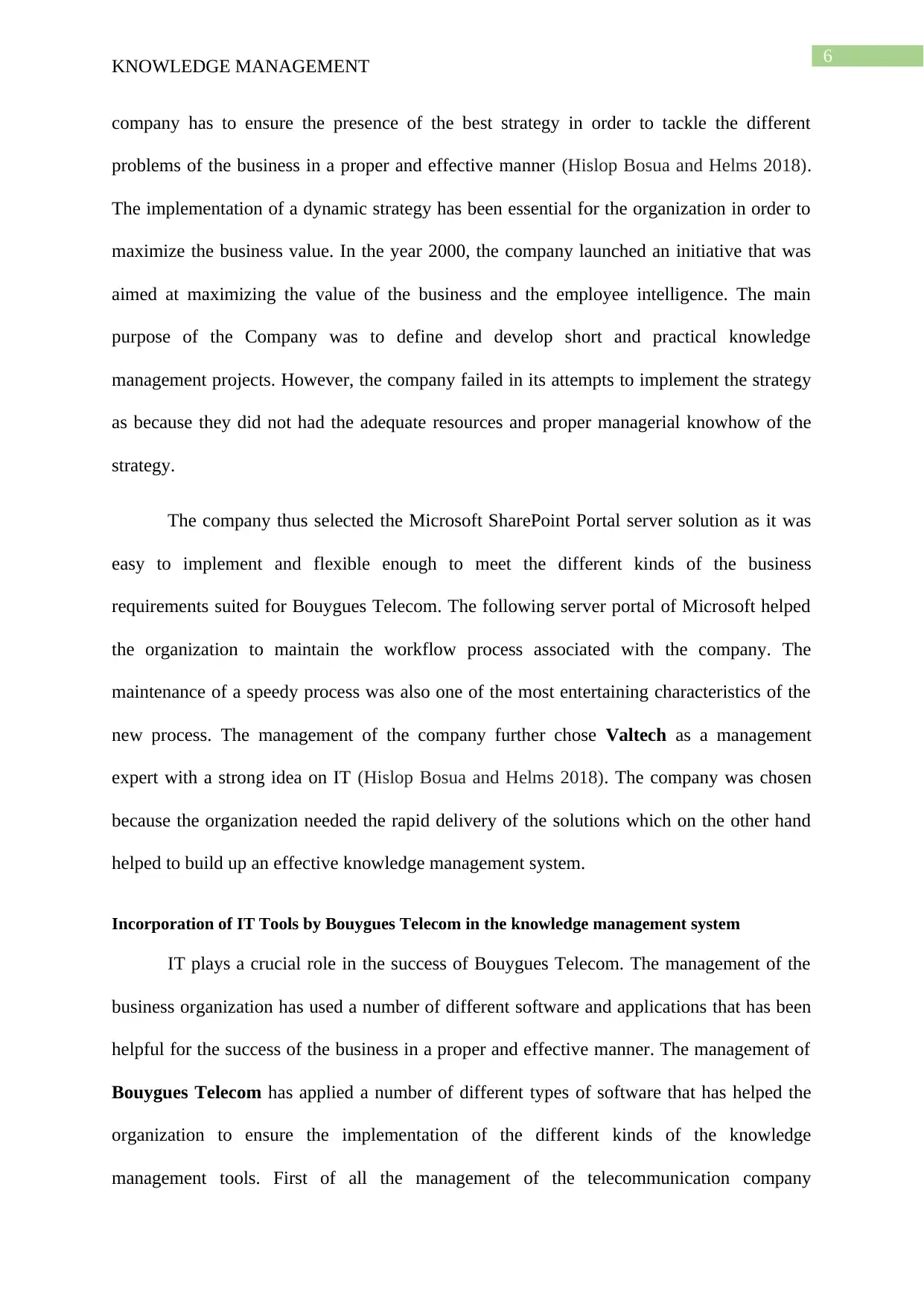
6
KNOWLEDGE MANAGEMENT
company has to ensure the presence of the best strategy in order to tackle the different
problems of the business in a proper and effective manner (Hislop Bosua and Helms 2018).
The implementation of a dynamic strategy has been essential for the organization in order to
maximize the business value. In the year 2000, the company launched an initiative that was
aimed at maximizing the value of the business and the employee intelligence. The main
purpose of the Company was to define and develop short and practical knowledge
management projects. However, the company failed in its attempts to implement the strategy
as because they did not had the adequate resources and proper managerial knowhow of the
strategy.
The company thus selected the Microsoft SharePoint Portal server solution as it was
easy to implement and flexible enough to meet the different kinds of the business
requirements suited for Bouygues Telecom. The following server portal of Microsoft helped
the organization to maintain the workflow process associated with the company. The
maintenance of a speedy process was also one of the most entertaining characteristics of the
new process. The management of the company further chose Valtech as a management
expert with a strong idea on IT (Hislop Bosua and Helms 2018). The company was chosen
because the organization needed the rapid delivery of the solutions which on the other hand
helped to build up an effective knowledge management system.
Incorporation of IT Tools by Bouygues Telecom in the knowledge management system
IT plays a crucial role in the success of Bouygues Telecom. The management of the
business organization has used a number of different software and applications that has been
helpful for the success of the business in a proper and effective manner. The management of
Bouygues Telecom has applied a number of different types of software that has helped the
organization to ensure the implementation of the different kinds of the knowledge
management tools. First of all the management of the telecommunication company
KNOWLEDGE MANAGEMENT
company has to ensure the presence of the best strategy in order to tackle the different
problems of the business in a proper and effective manner (Hislop Bosua and Helms 2018).
The implementation of a dynamic strategy has been essential for the organization in order to
maximize the business value. In the year 2000, the company launched an initiative that was
aimed at maximizing the value of the business and the employee intelligence. The main
purpose of the Company was to define and develop short and practical knowledge
management projects. However, the company failed in its attempts to implement the strategy
as because they did not had the adequate resources and proper managerial knowhow of the
strategy.
The company thus selected the Microsoft SharePoint Portal server solution as it was
easy to implement and flexible enough to meet the different kinds of the business
requirements suited for Bouygues Telecom. The following server portal of Microsoft helped
the organization to maintain the workflow process associated with the company. The
maintenance of a speedy process was also one of the most entertaining characteristics of the
new process. The management of the company further chose Valtech as a management
expert with a strong idea on IT (Hislop Bosua and Helms 2018). The company was chosen
because the organization needed the rapid delivery of the solutions which on the other hand
helped to build up an effective knowledge management system.
Incorporation of IT Tools by Bouygues Telecom in the knowledge management system
IT plays a crucial role in the success of Bouygues Telecom. The management of the
business organization has used a number of different software and applications that has been
helpful for the success of the business in a proper and effective manner. The management of
Bouygues Telecom has applied a number of different types of software that has helped the
organization to ensure the implementation of the different kinds of the knowledge
management tools. First of all the management of the telecommunication company
⊘ This is a preview!⊘
Do you want full access?
Subscribe today to unlock all pages.

Trusted by 1+ million students worldwide
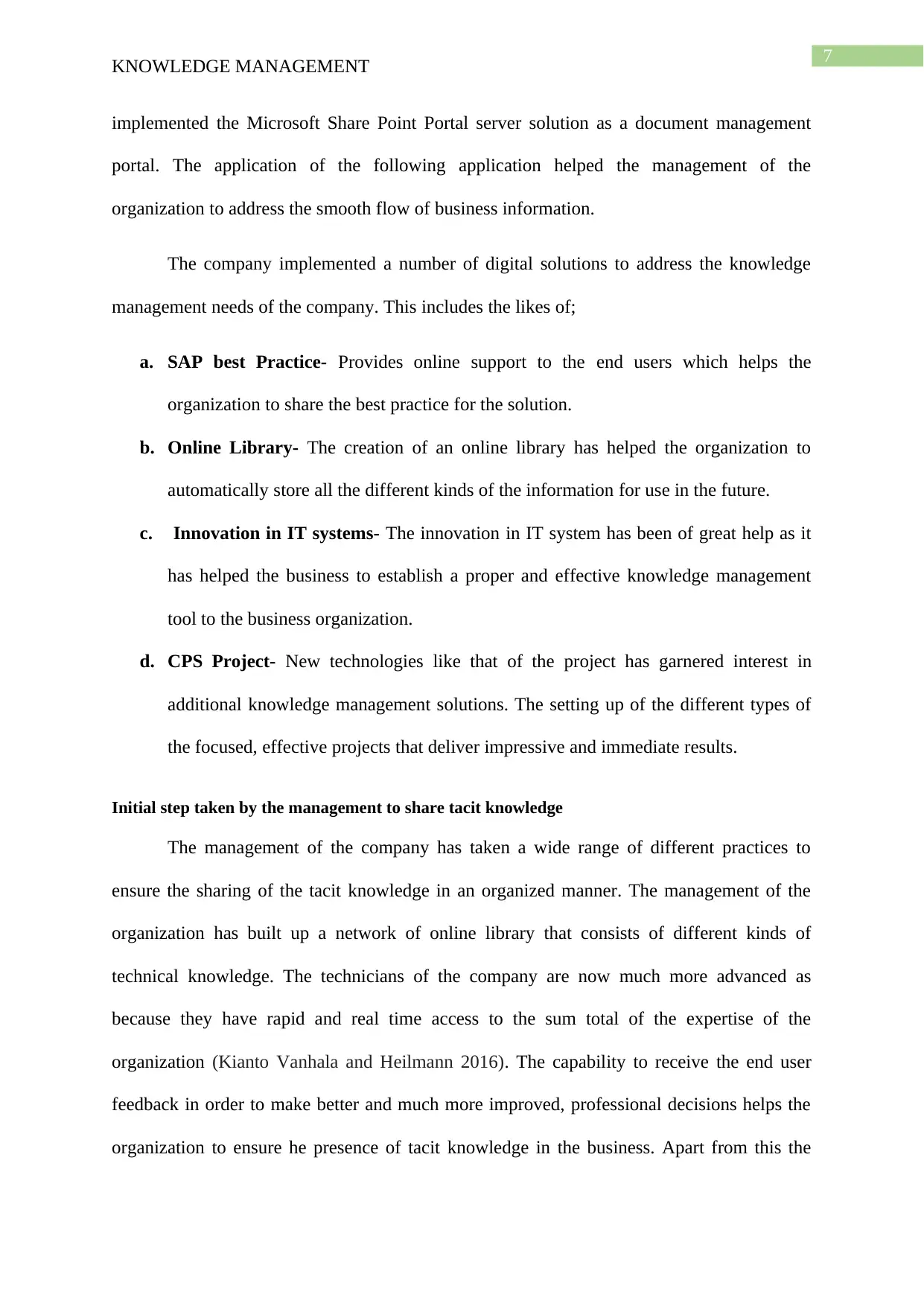
7
KNOWLEDGE MANAGEMENT
implemented the Microsoft Share Point Portal server solution as a document management
portal. The application of the following application helped the management of the
organization to address the smooth flow of business information.
The company implemented a number of digital solutions to address the knowledge
management needs of the company. This includes the likes of;
a. SAP best Practice- Provides online support to the end users which helps the
organization to share the best practice for the solution.
b. Online Library- The creation of an online library has helped the organization to
automatically store all the different kinds of the information for use in the future.
c. Innovation in IT systems- The innovation in IT system has been of great help as it
has helped the business to establish a proper and effective knowledge management
tool to the business organization.
d. CPS Project- New technologies like that of the project has garnered interest in
additional knowledge management solutions. The setting up of the different types of
the focused, effective projects that deliver impressive and immediate results.
Initial step taken by the management to share tacit knowledge
The management of the company has taken a wide range of different practices to
ensure the sharing of the tacit knowledge in an organized manner. The management of the
organization has built up a network of online library that consists of different kinds of
technical knowledge. The technicians of the company are now much more advanced as
because they have rapid and real time access to the sum total of the expertise of the
organization (Kianto Vanhala and Heilmann 2016). The capability to receive the end user
feedback in order to make better and much more improved, professional decisions helps the
organization to ensure he presence of tacit knowledge in the business. Apart from this the
KNOWLEDGE MANAGEMENT
implemented the Microsoft Share Point Portal server solution as a document management
portal. The application of the following application helped the management of the
organization to address the smooth flow of business information.
The company implemented a number of digital solutions to address the knowledge
management needs of the company. This includes the likes of;
a. SAP best Practice- Provides online support to the end users which helps the
organization to share the best practice for the solution.
b. Online Library- The creation of an online library has helped the organization to
automatically store all the different kinds of the information for use in the future.
c. Innovation in IT systems- The innovation in IT system has been of great help as it
has helped the business to establish a proper and effective knowledge management
tool to the business organization.
d. CPS Project- New technologies like that of the project has garnered interest in
additional knowledge management solutions. The setting up of the different types of
the focused, effective projects that deliver impressive and immediate results.
Initial step taken by the management to share tacit knowledge
The management of the company has taken a wide range of different practices to
ensure the sharing of the tacit knowledge in an organized manner. The management of the
organization has built up a network of online library that consists of different kinds of
technical knowledge. The technicians of the company are now much more advanced as
because they have rapid and real time access to the sum total of the expertise of the
organization (Kianto Vanhala and Heilmann 2016). The capability to receive the end user
feedback in order to make better and much more improved, professional decisions helps the
organization to ensure he presence of tacit knowledge in the business. Apart from this the
Paraphrase This Document
Need a fresh take? Get an instant paraphrase of this document with our AI Paraphraser
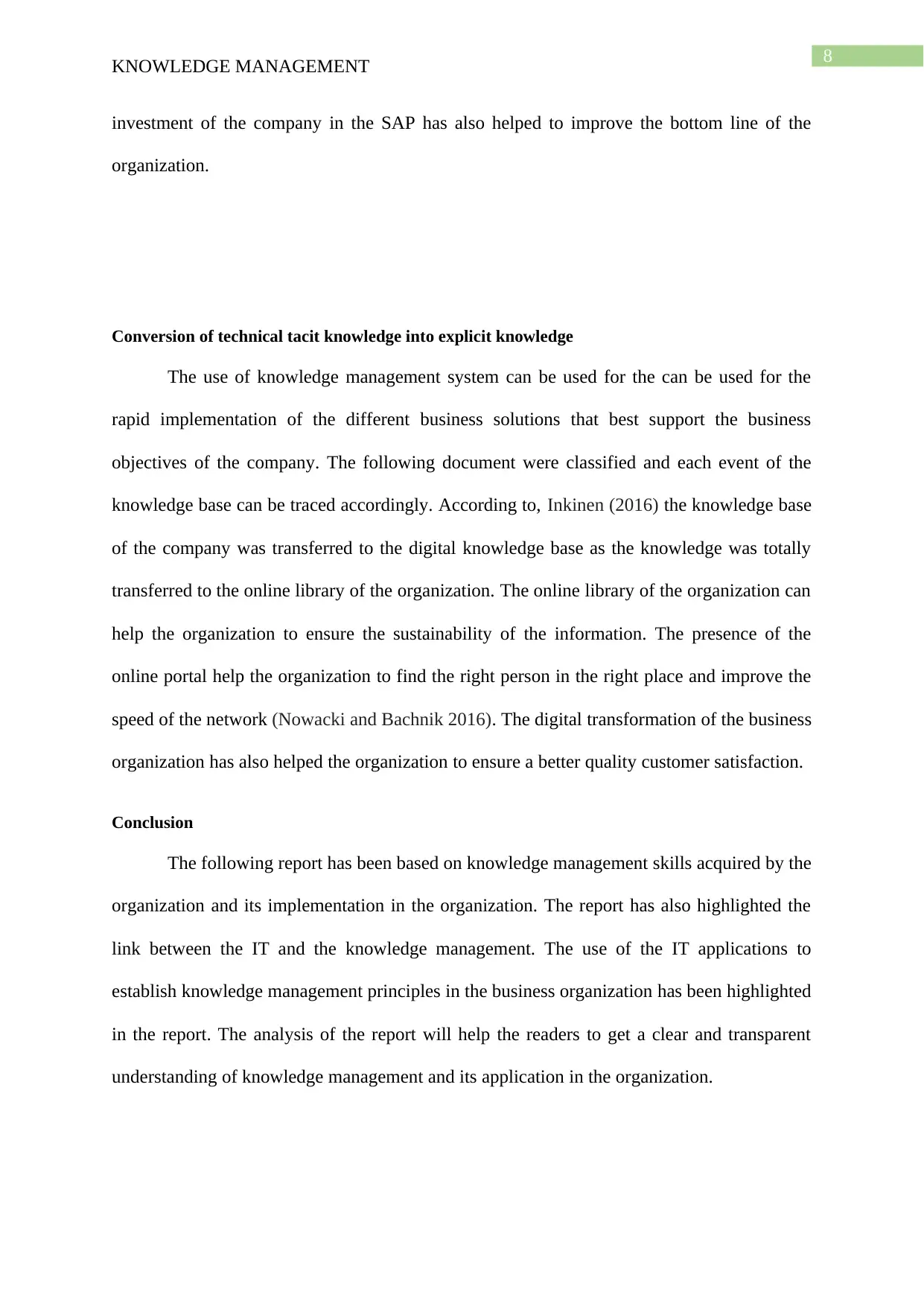
8
KNOWLEDGE MANAGEMENT
investment of the company in the SAP has also helped to improve the bottom line of the
organization.
Conversion of technical tacit knowledge into explicit knowledge
The use of knowledge management system can be used for the can be used for the
rapid implementation of the different business solutions that best support the business
objectives of the company. The following document were classified and each event of the
knowledge base can be traced accordingly. According to, Inkinen (2016) the knowledge base
of the company was transferred to the digital knowledge base as the knowledge was totally
transferred to the online library of the organization. The online library of the organization can
help the organization to ensure the sustainability of the information. The presence of the
online portal help the organization to find the right person in the right place and improve the
speed of the network (Nowacki and Bachnik 2016). The digital transformation of the business
organization has also helped the organization to ensure a better quality customer satisfaction.
Conclusion
The following report has been based on knowledge management skills acquired by the
organization and its implementation in the organization. The report has also highlighted the
link between the IT and the knowledge management. The use of the IT applications to
establish knowledge management principles in the business organization has been highlighted
in the report. The analysis of the report will help the readers to get a clear and transparent
understanding of knowledge management and its application in the organization.
KNOWLEDGE MANAGEMENT
investment of the company in the SAP has also helped to improve the bottom line of the
organization.
Conversion of technical tacit knowledge into explicit knowledge
The use of knowledge management system can be used for the can be used for the
rapid implementation of the different business solutions that best support the business
objectives of the company. The following document were classified and each event of the
knowledge base can be traced accordingly. According to, Inkinen (2016) the knowledge base
of the company was transferred to the digital knowledge base as the knowledge was totally
transferred to the online library of the organization. The online library of the organization can
help the organization to ensure the sustainability of the information. The presence of the
online portal help the organization to find the right person in the right place and improve the
speed of the network (Nowacki and Bachnik 2016). The digital transformation of the business
organization has also helped the organization to ensure a better quality customer satisfaction.
Conclusion
The following report has been based on knowledge management skills acquired by the
organization and its implementation in the organization. The report has also highlighted the
link between the IT and the knowledge management. The use of the IT applications to
establish knowledge management principles in the business organization has been highlighted
in the report. The analysis of the report will help the readers to get a clear and transparent
understanding of knowledge management and its application in the organization.
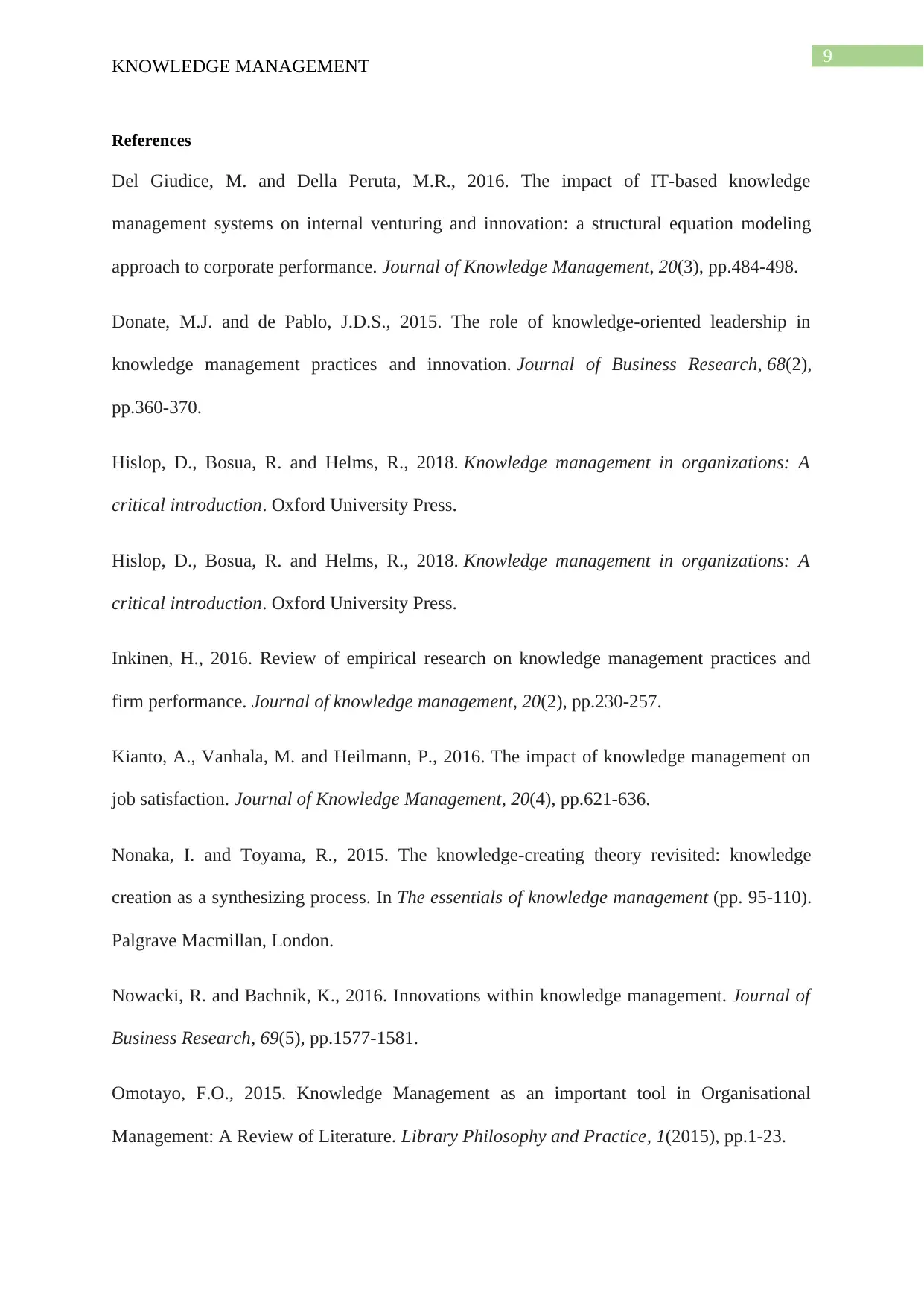
9
KNOWLEDGE MANAGEMENT
References
Del Giudice, M. and Della Peruta, M.R., 2016. The impact of IT-based knowledge
management systems on internal venturing and innovation: a structural equation modeling
approach to corporate performance. Journal of Knowledge Management, 20(3), pp.484-498.
Donate, M.J. and de Pablo, J.D.S., 2015. The role of knowledge-oriented leadership in
knowledge management practices and innovation. Journal of Business Research, 68(2),
pp.360-370.
Hislop, D., Bosua, R. and Helms, R., 2018. Knowledge management in organizations: A
critical introduction. Oxford University Press.
Hislop, D., Bosua, R. and Helms, R., 2018. Knowledge management in organizations: A
critical introduction. Oxford University Press.
Inkinen, H., 2016. Review of empirical research on knowledge management practices and
firm performance. Journal of knowledge management, 20(2), pp.230-257.
Kianto, A., Vanhala, M. and Heilmann, P., 2016. The impact of knowledge management on
job satisfaction. Journal of Knowledge Management, 20(4), pp.621-636.
Nonaka, I. and Toyama, R., 2015. The knowledge-creating theory revisited: knowledge
creation as a synthesizing process. In The essentials of knowledge management (pp. 95-110).
Palgrave Macmillan, London.
Nowacki, R. and Bachnik, K., 2016. Innovations within knowledge management. Journal of
Business Research, 69(5), pp.1577-1581.
Omotayo, F.O., 2015. Knowledge Management as an important tool in Organisational
Management: A Review of Literature. Library Philosophy and Practice, 1(2015), pp.1-23.
KNOWLEDGE MANAGEMENT
References
Del Giudice, M. and Della Peruta, M.R., 2016. The impact of IT-based knowledge
management systems on internal venturing and innovation: a structural equation modeling
approach to corporate performance. Journal of Knowledge Management, 20(3), pp.484-498.
Donate, M.J. and de Pablo, J.D.S., 2015. The role of knowledge-oriented leadership in
knowledge management practices and innovation. Journal of Business Research, 68(2),
pp.360-370.
Hislop, D., Bosua, R. and Helms, R., 2018. Knowledge management in organizations: A
critical introduction. Oxford University Press.
Hislop, D., Bosua, R. and Helms, R., 2018. Knowledge management in organizations: A
critical introduction. Oxford University Press.
Inkinen, H., 2016. Review of empirical research on knowledge management practices and
firm performance. Journal of knowledge management, 20(2), pp.230-257.
Kianto, A., Vanhala, M. and Heilmann, P., 2016. The impact of knowledge management on
job satisfaction. Journal of Knowledge Management, 20(4), pp.621-636.
Nonaka, I. and Toyama, R., 2015. The knowledge-creating theory revisited: knowledge
creation as a synthesizing process. In The essentials of knowledge management (pp. 95-110).
Palgrave Macmillan, London.
Nowacki, R. and Bachnik, K., 2016. Innovations within knowledge management. Journal of
Business Research, 69(5), pp.1577-1581.
Omotayo, F.O., 2015. Knowledge Management as an important tool in Organisational
Management: A Review of Literature. Library Philosophy and Practice, 1(2015), pp.1-23.
⊘ This is a preview!⊘
Do you want full access?
Subscribe today to unlock all pages.

Trusted by 1+ million students worldwide

10
KNOWLEDGE MANAGEMENT
Soto-Acosta, P. and Cegarra-Navarro, J.G., 2016. New ICTs for knowledge management in
organizations. Journal of Knowledge Management, 20(3), pp.417-422.
Todorović, M.L., Petrović, D.Č., Mihić, M.M., Obradović, V.L. and Bushuyev, S.D., 2015.
Project success analysis framework: A knowledge-based approach in project
management. International Journal of Project Management, 33(4), pp.772-783.
Webb, S.P., 2017. Knowledge management: Linchpin of change. Routledge.
KNOWLEDGE MANAGEMENT
Soto-Acosta, P. and Cegarra-Navarro, J.G., 2016. New ICTs for knowledge management in
organizations. Journal of Knowledge Management, 20(3), pp.417-422.
Todorović, M.L., Petrović, D.Č., Mihić, M.M., Obradović, V.L. and Bushuyev, S.D., 2015.
Project success analysis framework: A knowledge-based approach in project
management. International Journal of Project Management, 33(4), pp.772-783.
Webb, S.P., 2017. Knowledge management: Linchpin of change. Routledge.
1 out of 10
Related Documents
Your All-in-One AI-Powered Toolkit for Academic Success.
+13062052269
info@desklib.com
Available 24*7 on WhatsApp / Email
![[object Object]](/_next/static/media/star-bottom.7253800d.svg)
Unlock your academic potential
Copyright © 2020–2025 A2Z Services. All Rights Reserved. Developed and managed by ZUCOL.




